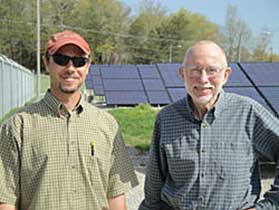Solar Leasing: Crediting Electric Bills with the Sun
Energy distribution for the people, by the people. That was the founding principle of electric cooperatives and municipal utilities as they sprang up in the United States throughout the twentieth century.
Today, any profits made by these member- or city-owned utilities go back into infrastructure, operation, or payments towards their member-investors. Seldom have they veered from the distribution game and tried generating their own energy, but across the country this is beginning to change. It’s a new tide in the energy world driven by the pull of solar power.
In 2009, the city of Berea, Ky., wishing to upgrade its energy infrastructure, applied for the federal Energy Efficiency and Conservation Block Grant, which aids the development of energy efficiency and conservation programs for small municipalities. Within a year, Berea was awarded $125,000.
“Most of the money went to lighting upgrades and municipal energy efficiency programs, but twenty-five percent was set aside for Berea Solar Farm,” says Joshua Bills, a program coordinator at the Mountain Association for Community Economic Development, a non-profit that promotes energy efficiency in Appalachian Kentucky.

- Raising the Standard: State Laws and our Clean Energy Future
- Democratizing the Grid: Community-owned Renewable Energy
- Bio-energy Creates a Mass of Questions
- Beyond Renewable: The Cutting Edge in Energy
- A Guide to Clean Energy Incentives

In Berea, the push for solar generation came largely from community members. “One of the main benefits of this utility is that its advisory board is made up of non-staff members,” says Bills, currently the board’s chair. “Lots of different voices have been given avenues.”
The idea for the solar farm itself came about in part due to Steve Boyce, former chair of the Berea Utilities Advisory Board, who was inspired by the success of a similar venture in Colorado.
United Power, a rural electric co-op near Denver, began allowing its customers to not just lease panels that the utility built and maintained on its site, but earn credits directly back on their electric bills as well.
The model at United Power helped shape Berea’s plan, where the cooperative initially allowed leases of up to two of its 240-watt solar panels per customer. “All leases were gone before the initial construction was finished,” says Bills.
The program quickly doubled to 120 panels and now customers can lease as many as they like, with each costing $750 for 25 years. While Berea Utilities maintains and owns the panels, leasing customers own the energy produced.
Those who lease don’t have to worry about maintenance and they get a fair price on solar, a deal of about $3.15 per installed watt. According to the Department of Energy, as early as 2011 the median cost of installing residential solar panels similar to Berea’s panels was $6.13 per watt.
Berea’s solar program is looking to expand. A new batch of 132 panels is currently being installed on the wastewater treatment site. More panels are planned in upcoming phases and will eventually allow an opportunity for customers to completely offset their electricity use with solar. This new construction should be completed in the next couple of months, says Bills.
While the complete turnover of the utility’s energy distribution to purely solar is a long way off, customers applying today for leases can potentially achieve a full solar-offset in the future.
Related Articles
Latest News

Leave a comment
Your email address will not be published. Required fields are marked *






Leave a Comment